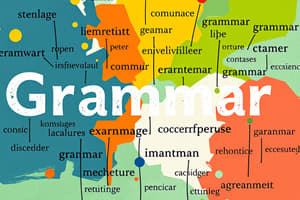Podcast
Questions and Answers
What is the most common sentence structure in English?
What is the most common sentence structure in English?
- Verb-Subject-Object
- Object-Subject-Verb
- Verb-Object-Subject
- Subject-Verb-Object (correct)
Which of the following represents the number of vowel sounds in English?
Which of the following represents the number of vowel sounds in English?
- 10
- 12 (correct)
- 14
- 16
Who is known for contributing to the standardization of American English spelling?
Who is known for contributing to the standardization of American English spelling?
- Noah Webster (correct)
- George Orwell
- Samuel Johnson
- William Shakespeare
How many phonemes are typically found in the English language?
How many phonemes are typically found in the English language?
Which method is widely used in teaching English as a second language?
Which method is widely used in teaching English as a second language?
What are the two major varieties of English that differ in spelling, vocabulary, and grammar?
What are the two major varieties of English that differ in spelling, vocabulary, and grammar?
Which of the following is NOT a part of speech in English grammar?
Which of the following is NOT a part of speech in English grammar?
Which of the following describes one of the functions of adverbs in a sentence?
Which of the following describes one of the functions of adverbs in a sentence?
Study Notes
Overview of the English Language
- Origin: Developed from Old English, influenced by Latin, Norse, and Norman French.
- Language Family: Part of the Germanic branch of the Indo-European language family.
Phonetics and Phonology
- Phonemes: Basic sounds in English; 44 phonemes typically exist.
- Vowels: 12 distinct vowel sounds including long and short variants.
- Consonants: 24 consonant phonemes; includes voiced/unvoiced sounds.
Grammar
-
Parts of Speech:
- Nouns: Names of people, places, things, or ideas.
- Verbs: Action or state of being.
- Adjectives: Describe nouns.
- Adverbs: Modify verbs, adjectives, or other adverbs.
- Pronouns: Replace nouns.
- Prepositions: Show relationships between nouns.
- Conjunctions: Connect words or phrases.
-
Sentence Structure:
- Subject-Verb-Object (SVO) is the most common order.
- Types of sentences: Declarative, interrogative, imperative, exclamatory.
Vocabulary
- Lexicon: Over 600,000 words; constantly evolving.
- Word Formation: Includes derivation, compounding, and borrowing from other languages.
Tenses
- Present: Simple, continuous, perfect, perfect continuous.
- Past: Simple, continuous, perfect, perfect continuous.
- Future: Simple, continuous, perfect, perfect continuous.
Writing System
- Alphabet: Uses the Latin alphabet with 26 letters.
- Punctuation: Essential for meaning; includes periods, commas, question marks, etc.
Dialects and Varieties
- British vs. American English: Differences in spelling, vocabulary, and grammar.
- Regional Dialects: Variations within English-speaking countries (e.g., Australian, Canadian, Indian).
Literature and Usage
- Genres: Poetry, prose, drama; rich literary history from Chaucer to modern authors.
- Functional English: Used in business, academia, and everyday communication; emphasis on clarity and conciseness.
Learning and Teaching
- Methods: Immersion, communicative approach, task-based learning.
- Resources: Textbooks, online courses, language exchange programs.
Important Figures
- William Shakespeare: Influential playwright and poet; expanded English vocabulary.
- Noah Webster: American lexicographer; contributed to standardizing American English spelling.
Overview of the English Language
- Originated from Old English and has been shaped by Latin, Norse, and Norman French influences.
- Belongs to the Germanic branch of the Indo-European language family.
Phonetics and Phonology
- Comprises approximately 44 phonemes, the foundational sounds in English.
- Contains 12 unique vowel sounds with both long and short variations.
- Features 24 consonant phonemes, which can be categorized as voiced or unvoiced.
Grammar
- Parts of Speech:
- Nouns identify entities like people, places, things, or abstract concepts.
- Verbs express actions or states of being.
- Adjectives provide description for nouns.
- Adverbs modify verbs, adjectives, or other adverbs.
- Pronouns serve as substitutes for nouns.
- Prepositions indicate relationships between nouns.
- Conjunctions link words or phrases to create connections.
- Sentence Structure:
- Predominantly follows a Subject-Verb-Object (SVO) order.
- Types of sentences include declarative, interrogative, imperative, and exclamatory.
Vocabulary
- Contains over 600,000 words and is continuously evolving.
- Word formation processes include derivation, compounding, and borrowing from other languages.
Tenses
- Present Tense includes simple, continuous, perfect, and perfect continuous forms.
- Past Tense also has simple, continuous, perfect, and perfect continuous variations.
- Future Tense is categorized into simple, continuous, perfect, and perfect continuous forms.
Writing System
- Utilizes the Latin alphabet consisting of 26 letters.
- Punctuation is critical for expressing meaning, incorporating elements like periods, commas, and question marks.
Dialects and Varieties
- Differences between British and American English arise in spelling, vocabulary, and grammar usage.
- Regional dialects exist across English-speaking nations, such as Australian, Canadian, and Indian English.
Literature and Usage
- Includes various genres: poetry, prose, and drama, showcasing a rich literary tradition from figures like Chaucer to contemporary authors.
- Functional English serves in business, academia, and daily communication, prioritizing clarity and conciseness.
Learning and Teaching
- Various learning methods include immersion, the communicative approach, and task-based learning.
- Resources for learning English encompass textbooks, online courses, and language exchange programs.
Important Figures
- William Shakespeare significantly impacted the English language as a playwright and poet, enriching its vocabulary.
- Noah Webster played a key role in standardizing American English spelling through his work as a lexicographer.
Studying That Suits You
Use AI to generate personalized quizzes and flashcards to suit your learning preferences.
Description
Test your knowledge on the origins, phonetics, grammar, and vocabulary of the English language. This quiz covers key concepts including phonemes, parts of speech, and sentence structures. Perfect for language learners and enthusiasts!




